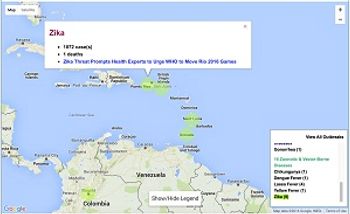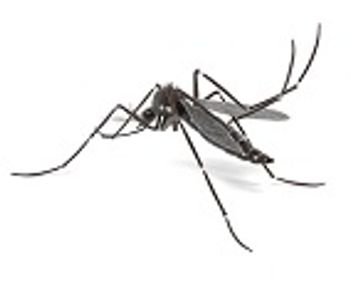
Contagion has launched a global Outbreak Monitor that allows users to visualize occurrences of infectious diseases, such as Zika and Yellow Fever, on a local, regional, national and international level.

Contagion has launched a global Outbreak Monitor that allows users to visualize occurrences of infectious diseases, such as Zika and Yellow Fever, on a local, regional, national and international level.

Public health demands integrity, said Margaret Hamburg, MD, former commissioner of the US Food and Drug Administration (FDA), at the Centers for Disease Control and Prevention’s 65th Annual Epidemic Intelligence Service (EIS) Conference in Atlanta, Georgia.

Incidence of syphilis is on the rise in Europe—particularly among men—according to a report released in May by the European Centre for Disease Prevention and Control (ECDC).

Recent studies on Zika have lead researchers to discover how the virus causes neurological complications, as well as ways in which the body can fight off the infection.

The FDA recently granted Emergency Use Authorization for the Idylla Ebola Virus Triage Test, a diagnostic test which detects the presence of the virus in blood.

Each year, norovirus infection is responsible for an estimated 684 million episodes of diarrhea and 212,000 deaths worldwide, and results in approximately $4.2 billion in healthcare costs and $60.3 billion in societal costs, a new report has highlighted.

With reports in the mainstream media prophesizing doom with regard to the issue of antimicrobial resistance, a committee formed by the British government has released a report designed to properly contextualize the crisis and develop recommendations for addressing it.

A recent review article on the status of vaccines in development for healthcare associated infections (HAIs) provides both an in-depth discussion of their urgent need, as well as their potential for success.

A recent report describing the development of “flesh-eating bacteria” in a Louisiana woman has the public concerned. The infection developed after the woman injured her foot, resulting in bleeding, while surf fishing in the Gulf of Mexico earlier this May.

In an open letter copied to the International Olympic Committee, 150 health experts from around the world urged the WHO Director-General, Margaret Chan, MD, MPH, to either postpone or move both the Olympic and Paralympic Games, for the sake of public health.

Efforts to bring to market a vaccine for the fight against Zika virus, at least via the private sector, have been stalled over concerns regarding the “marketability” of these products, according to multiple reports in the business press.

Management of visceral leishmaniasis poses a daunting challenge, in part due to the side effects associated with the use of the traditional treatment. However, one vaccine development strategy has recently shown promising results.

For the first time, a recent study has captured African monkeys eating bats—a finding that raises concern about the spread of zoonotic diseases such as Ebola.

A recently published article in an Indian newspaper claims that thousands of civilians living across the country have contracted HIV through blood transfusions, in less than two years; however, a national AIDS organization is refuting these claims.

In an attempt to provide the best possible care for her unborn child, a Honduras woman with suspected Zika infection traveled to the United States where she then gave birth to a baby with microcephaly at Hackensack University Medical Center.

A recent study in treatment-naïve patients with chronic hepatitis C virus (HCV) infection has shown that ledipasvir/sofosbuvir (LDV/SOF) combination therapy produces similar sustained virologic response (SVR) rates in clinical trial-based studies and real-world studies.

On May 31, 2016, the Centers for Disease Control and Prevention (CDC) updated its interim guidance on screening for, and diagnosis of, Zika virus.

Researchers have identified the first-ever reported cases of yellow fever in China, tracing their origins to travelers from Angola, where there is an ongoing outbreak.

Clostridium difficile infection (CDI) can be spread between facilities, particularly in older adults. One study has found that collaboration between facilities may help curb the spread of this potentially deadly infection.

The number of expecting mothers who opt for annual vaccination for influenza during pregnancy remains relatively low; however, the results of a new study suggest this may be changing—and that there are obvious benefits for immunization for newborns.

Healthcare-associated infections (HAIs) can have dramatic effects on excess morbidity and associated costs and so finding effective and efficient way to prevent them is important.

Makers of specially modified mosquitoes designed to combat the Zika virus have approached regulatory bodies in multiple countries seeking approval to use their products in the fight against the mosquito-borne virus.

The Centers for Disease Control and Prevention (CDC) has released updated guidelines for the use of nonoccupational post-exposure prophylaxis (nPEP) in persons in the United States, after exposure to human immunodeficiency virus (HIV) outside the health care setting.

Zika virus is transmitted from mother to fetus through placental macrophages, according to a new study.

A program designed to improve the quality of influenza surveillance capabilities in 39 countries from around the globe through partnership with the Centers for Disease Control and Prevention (CDC) seems to have resulted in remarkable progress on all six of the assessed metrics, and even led to improvements in the surveillance of other pathogens, according to the results of a recent study.

The era of antibiotic futility is approaching, so why aren't we taking it seriously?

The Zika virus has left many scientists and doctors “astonished,” according to Margaret Chan, MD, MPH, director-general of WHO.

The level of hemagglutination inhibition (HAI) used as the traditional gold standard for evaluating influenza vaccines in the United States and European Union may not actually be the best predictor of protection from influenza virus-induced disease.

Although virtually eradicated in some parts of the developed world, spinal meningitis remains a significant healthcare challenge in the so-called “African meningitis belt,” a region of 26 countries that stretches from Senegal to Ethiopia.

Researchers have identified US Food and Drug Administration (FDA)-approved drugs that could help in the fight against post-treatment Lyme disease syndrome (PTLDS).